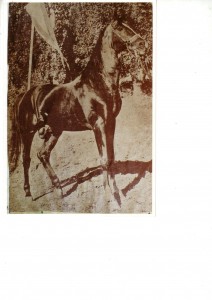Shaykh al-‘Arab, forgotten king of a lost kingdom
The dark chestnut stallion Shaykh al-‘Arab is one of the foundation stallions of the (now defunct) Lebanese Asil Arabian horse breeding. Born in the desert somewhere between Hims and Palmyra, he was bred by Rakan ibn Mirshid, Shaykh of the Gomussah section of the Sba’ah Bedouin tribe in the 1930s, then sold to Beirut for racing.
His sire was a desert-bred Ma’naghi Sbayli, the stallion of ‘Awdah al-Mis’ir of Sba’ah, and his dam a ‘Ubayyat al-Usayli’, one of the best marabit (pl. of marbat, i.e., desert stud) of ‘Ubayyan Sharrak among the Sba’ah tribe. [Other equally good marabit of ‘Ubayyan Sharrak with the Sba’ah tribe ainclude ‘Ubayyan ibn Duwayhiss, ‘Ubayyan al-‘Awbali, ‘Ubayyan ibn Thamdan, and ‘Ubayyan ibn ‘Alyan, the latter being the strain of the Blunt import Queen of Sheba, then owned by Beteyen Ibn Mirshid, Rakan’s ancestor.]
In Beirut, the horse was successfully raced by Henri Pharaon under the name of Shaykh al-‘Arab (a reference to his prestigious breeder), and then given to the Lebanese Ministry of Agriculture as a breeding stallion. Shaykh al-‘Arab’s sons and daughters became good race horses, so much so that veteran Syrian racehorse owner Ali al-Barazi recalled attending race in Beirut where the top four horses were all his daughters.
At one time in the nineteen seventies, most (if not all) of the Asil horses of Lebanon and many Asil horses in Syria traced to Shaykh al-’Arab in one way or another. One of his sons was even imported to the USA, where a thin line of Asil horses still traces to him (curious, eh?). Another son, Mash’al, also a ‘Ubayyan Sharrak (but tracing to the marbat of Ibn Thamdan) became the cornerstone of the Lebanese Asil breeding in the period immediately preceding the 15 year civil war (1975-1990). A daughter of Shaykh al-‘Arab, Zanubia, was the great-grand dam of my own Zanubia (III).
Today, nothing Asil remains of the precious blood of Shaykh al-‘Arab in Lebanon. We sod his last living descendent, a Tuwayssah mare (by Malek, by Achhal, by Mash’al, by Shaykh al-‘Arab), to Syria, in 1995. Syria actually still has a few horses tracing to Shaykh al-‘Arab through his grandson Mun’im, but I don’t know if they are being bred from.
Photo courtesy of Hazaim al-Wa’ir (but I don’t know where Hazaim got it from)

All the “Shaykh el Arab” blood is now in Qatar as the Syrian breeders sold the last 4 remaining mares to a Qatari Sheikh who breed them to non-asil stallions,when in the 90’s I tried ,togheter with Basil Jedaan the Syrian Arab Horse Association President,to buy them back,we were prohibited to do it because at that time there was a Syrian law prohibiting the importation of horses!!!!What a pity, Basil was so angry at that time.
Edouard, what line is it in the US that contains this lovely horse?
Yes, Edouard, we are curious — very! Please tell us.
This must be a reference to the Hindi import *Daham?
Michael, you’re right on! *Daham was by Shaykh al-‘Arab out of Muna, and bore a close resemblance to his sire..
That’s your cue to start explaining more about the Hindi horses! We do have a skull of one of the total Hindi descendants in our collection here.
Will get there, that was just an appetizer..
It’s curious, the printed stud book (vol. 8) gives *Daham by “Shaje El Arab” out of “Moona,” but DataSource omits this information.
That should say volume eight. I don’t understand where the “emoticon” came from.
The people who invented the blog software were trying to be cute. You’d get an emoticon each time you put an eight in the comment box.
edouard read your article on Daham’s sire very interesting Brahaim Jr.
Brahaim Jr. so good to hear from you again. I fondly recall the visit to Brahaim Sr in Vaughn, NM in 2001, and visiting with you and your brother. I was really honored to have met you. I still keep the ram skull Brahaim Sr gave me. I hope everyone is well.
The skull we have is of Hindi El Bulad, and from his skull, he must have been a lovely horse.